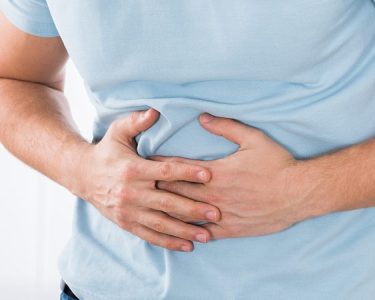Abdominal Adhesions Pain by Herbal Care Products
Abdominal Adhesions are strands or of scar tissue (fibrin bands; see illustration, below) that form in response to abdominal surgery and extend beyond the specific site of incision, sometimes forming separately from the incision site within the peritoneum. Scar tissue that mends the incision is normal, but the adhesions form additionally under some circumstances that are not fully understood. There are specific features of a surgical procedure that help induce the formation of adhesions. For example, drying of the tissues during surgery increases adhesion formation, a situation remedied by paying attention to the arid conditions and correcting them during then procedures. Intentional drying of the tissues, by applying gauze, is an otherwise desirable procedure to aid the surgeon’s view of the area, but because of increased adhesions, it must be minimized. Tissues that become dry should be quickly moistened and air (carbon dioxide) that is passed over the surgery site to maintain cleanliness also must contain adequate moisture to prevent rapid drying of the exposed fluids. Laparotomy (open abdominal surgery) is more likely to produce adhesions than surgery performed via laparoscopy in which a small scope with attached micro surgical instruments is inserted through a slit in the abdomen (1-3).
That’s all info posted by Herbal Care Products online company also treat abdominal adhesions pain. In our natural herbal products have Adhenical for patients abdominal adhesions natural herbal treatment at your home place. Abdominal adhesions natural treatment treat by nature and you get your health back. You can get best abdominal adhesions herbal treatment only from natural health products store. This post have your natural herbal treatment for abdominal adhesions. Natural treatment for abdominal adhesions you can use in all type of age. If you want online treatment then come here and get your herbal treatment for abdominal adhesions.
Left: a representation of a normal peritoneum, the transparent membrane that wraps the pelvic and abdominal organs. Right: after surgical trauma, fibrous bands of collagen grow as part of the normal healing process and form adhesions. Adhesions connect tissues or structures that are normally separate. Adhesions in the abdomen or pelvic area can lead to infertility, pelvic pain, small bowel obstruction, or the need for repeat surgery (1).
The incidence of adhesions following abdominal surgery is cumulative with multiple surgeries and female gynecological surgeries give a particularly high rate of adhesions. In one study, autopsy investigations indicated a 90% incidence of adhesions in patients with multiple surgeries, 70% incidence of adhesions in patients with a gynecologic surgery, a 50% incidence of adhesions with appendectomy, and a greater than 20% incidence of adhesions in patients with no surgical history. Adhesions may occur as the result of tissue damage to the abdomen besides surgery, including traumatic injury, inflammatory disease, intraperitoneal chemotherapy, and radiation therapy (1).
Related Article: 11 Natural Home Remedies for Abdominal Adhesions
The most frequent problem with adhesions is a constriction of the small intestine, producing constipation (sometimes complete bowel blockage, requiring emergency treatments). Abdominal pain is another common symptom, caused when the bands of scar tissue bind up the internal organs so that movements pull on them. Linkage of menstruation to changes in bowel function (e.g., inducing diarrhea) may occur as the result of scar tissue attaching the uterus to the intestine. Adhesions may also impair fertility in women by causing blockage of the fallopian tubes. It has been estimated that:
- At least one-third of women who suffer from pelvic pain have adhesions as a cause of or contributor to the pain.
- Adhesions involving the ovaries or fallopian tubes are responsible for 15-20 percent of female infertility cases.
- Small bowel obstruction is often a surgical emergency and is particularly common after gynecological surgery.
To prevent adhesion formation, surgeons may now apply a fine fabric barrier to surround the organs, thus isolating them from the scar tissue strands (the barrier dissolves after the surgery). Although adhesions can be removed by surgical intervention (adhesiolysis) using a laparoscopic technique (4), recent studies suggested that such surgery produces limited benefits that are often short-term. Many patients are treated with multiple adhesiolysis procedures in an attempt to improve the symptoms of adhesions. Each year, 400,000 adhesiolysis procedures are performed in the U.S., costing the health care system about $2 billion in hospitalization and surgeon expenses.
Most times, adhesions cause few, if any, notable effects. But, for those who do suffer from their adverse effects, the question arises as to whether the adhesions can be reduced or eliminated by methods other than further surgery.
CHINESE HERB MEDICINE FOR ADHESIONS
The problem of developing abdominal adhesions is noted in the Chinese medical literature. Dr. Fu Kezhi, at the Harbin office of ITM, carried out a literature search, yielding several studies summarized here.
Chinese medicine has been applied both to prevention of abdominal adhesions and to their treatment when they cause bowel blockage. The preventive measure involves relatively immediate post-surgical intervention. The basis of the preventive therapy is to treat the abdominal stasis that occurs following surgery. Normally, after an abdominal surgery, the bowels are virtually paralyzed for many hours, up to two days in older patients and complicated surgeries. Doctors and nurses check for the return of bowel sounds (indicating movements) after the surgery, to make sure recovery is proceeding. Since obstructive constipation is one of the primary responses to developing adhesions, concern about bowel stasis is a clear concern. In China, an herbal formula used for treating constipation is administered about 6 hours after surgery, to assure the action of the bowels in a relatively short time with continued bowel responsiveness, indicating lack of adhesion formation.
Related Article: Diagnosis and Treatment of Abdominal Adhesions
The formulas are usually a derivative of the ancient prescription Da Chengqi Tang (Major Rhubarb Combination). The traditional formula has four ingredients: rhubarb and mirabilitum as purgatives and chih-shih and magnolia as qi regulating herbs. The modifications of the formula usually involve adding additional qi regulating herbs (notably saussurea) and blood vitalizing herbs (especially persica, red peony, and salvia) to promote the circulation of qi and blood in the abdomen and prevent formation of adhesions, which are seen as the result of prolonged stasis. An example is the administration of a formula called Tao Zhi Zhi Po Fang, comprised of rhubarb, magnolia, chih-ko (in place of chih-shih), saussurea, persica, carthamus, leech, and salvia, provided 6 hours after abdominal surgery (5). Compared to a control group not treated with these herbs, bowel sounds and bowel functions resumed many hours earlier and the incidence of adhesions (determined by typical symptoms of adhesions appearing within the next three years) was significantly lowered.
In another report (6), a modified Major Rhubarb Combination was administered after surgery while during surgery a protective barrier fluid was used to isolate the organs and prevent adhesions. The authors noted:
Treatment by integrating traditional Chinese medicine and western medicine has been adopted in many surgical departments, especially the application of Modified Major Rhubarb Combination. The formula has the properties of inducing purgation, promoting qi circulation, resolving blood stagnation, and assuring that the hollow viscera remain unimpeded; specifically, stomach-qi can move downward freely to eliminate fullness and distention, the qi in the abdomen can circulate freely, and the bowels remain open; it can stimulate early peristalsis of the bowels after surgery. When using the Modified Major Rhubarb Combination soon after surgery for adhesive bowel obstruction, it can markedly shorten the time period of intestine paralysis.
Because the herbal treatment within hours after surgery is impractical for Western patients (and the use of purgatives would be objected to by the medical profession on grounds of it possibly causing damage), the question about treating existing adhesions arises. In Chinese investigations of this matter, the patients are usually those who have come to the hospital with a severe disorder, usually bowel blockage, for which surgery would be utilized. Patients may first be treated with herbs to see if this is successful in relieving the blockage, while surgery can be used as a back-up.
The non-surgical treatment of adhesion-induced medical crisis is similar to that used for the preventive measure after surgery, at least in cases involving bowel blockage. For example, in one evaluation (7), patients were treated with a derivative of Major Rhubarb Combination made with: rhubarb (15 g), magnolia (10 g), chih-shih (10 g), mirabilitum (20 g), persica (10g), red peony (15 g), and stir-fried raphanus (45 g). Raphanus (radish seed) is used to aid the downward flow of qi, normalize digestion, and alleviate abdominal pain. The herbs were administered in 1-2 batches a day, orally or through a stomach tube. Of 250 patients treated this way, 88% were able to avoid surgery. As with the method for preventing adhesions in the first place, there is some doubt that this approach would be used in the West, as there is concern about using strong purgative treatments when bowel blockage exists. In China, the patients are carefully monitored while pursuing this treatment as an inpatient and are referred to surgery if the problem is not promptly resolved.
Another report of this type of treatment approach involved use of two slightly different decoctions, depending on the differential diagnosis (8); these were:
- Modified Major Rhubarb Combination: rhubarb (10-30 g), mirabilitum (6-15 g), magnolia (20 g), chih-shih (10 g), persica (10 g), red peony (10 g), and stir-fried raphanus seed (30g)
- Adhesion Lysis Decoction: cassia leaf (10g), mirabilitum (6-10 g), magnolia (10 g), lindera (10 g), persica (10 g), red peony (10 g), and stir-fried raphanus seed (10 g).
These formulations could be modified: for severe pain, add 10 grams each of corydalis, frankincense, and myrrh; for a case with vomiting, add 10 grams pinellia and 30 grams raw hematite.
As in the previous study, these formulas prevented the need for surgery in about 86% of cases. Presumably, these therapies could be applied to Western patients suffering from constipation that has not developed into full obstruction requiring hospitalization; the formulas are not inherently different from traditional herb prescriptions now administered for acute constipation. For example, Major Rhubarb Combination is routinely sold as a dried extract granule by several Chinese herb suppliers worldwide.
A limitation of the purgative herb therapy is that while it relieves the immediate crisis, the problem can return, because the adhesions are not gone. An attempt to resolve this dilemma was designed on the basis of using Chinese herb therapy to treat the obstructive crisis and then using laparoscopic surgery to remove the adhesions to prevent further occurrences. By so doing, one can usually avoid emergency surgery as a result of intestinal obstruction; instead, the surgery can proceed at a time when the intestinal functions have normalized and a less invasive surgical technique (laparoscopic surgery) can be utilized. In one study using this two-stage method (9), patients received one of three basic herb therapies for the intestinal obstruction:
- Modified Major Rhubarb Combination: rhubarb, mirabilitum, chih-shih, magnolia, persica, red peony, and stir-fried raphanus seed;
- Euphorbia Obstruction-relieving Decoction: euphorbia (gansui), rhubarb, magnolia, saussurea, persica, achyranthes, and red peony; or
- Entero-adhesion Lysis Decoction: cassia leaf, mirabilitum, magnolia, saussurea, lindera, persica, red peony, and stir-fried raphanus
In these formulations, rhubarb, euphorbia, and cassia leaf all serve the same function of inducing peristalsis. The purgative herb is the central ingredient in treatment, while the others are supportive; in one study (10), euphorbia was used as a single herb to treat intestinal obstruction due to adhesions in order to prevent the need for surgery.
The desire of most patients would be to alleviate the problem of adhesions before a crisis of bowel obstruction occurs, and to treat other manifestations of adhesions, such as abdominal pain and reduced fertility. The Chinese literature appears silent on this issue, but there are some possibilities to be considered.
CAN ADHESIONS BE MODIFIED OR REMOVED WITHOUT SURGERY?
Doctors and researchers are aware that scar tissue is difficult to remove or alter. One method of degrading undesirable scar tissue that has shown promise is to apply hyaluronidase, a mucolytic enzyme. Hyaluronidase breaks down hyaluronic acid, an ingredient of connective tissue. It is injected into the scar and may work best if the scar if physically degraded by surgical means and then treated by the enzyme to prevent reformation of the original scar mass. A new application of hyaluronidase is to provide it during surgery: protective barriers infused with hyaluronidase are being tried in an effort to further reduce the formation of the adhesions.
Related Article: Natural Treatment for Abdominal Adhesions Reviews 2023
The fact that existing scars may be degraded somewhat by the enzyme action suggests the possibility that herbal therapies could contribute to alleviating adhesion symptoms by stimulating the body’s production of hyaluronidase (or other enzymes of similar function) to perform this task. Even if scar tissue is not removed, if it can be softened (made more elastic), there may be relief from its physical manifestations such as bowel blockage, pain, and some cases of infertility. Herbs that are reputed to aid healing of injuries, soften abdominal masses, and alleviate abdominal pain of various origins may act, in part, by breaking down undesirable collagens to alleviate the symptoms. Antifibrotic and mass reducing herbs are used to treat abdominal disorders such as uterine fibroids and liver fibrosis, and are also used to treat skin masses in scleroderma; it is possible that they function by increasing the degradation of fibrous tissue via hyaluronidase. Key herbs for reducing fibrosis and masses are listed in Table 1 (11).
SAMPLE FORMULATIONS AND TREATMENT STRATEGY
The herbs from the table above are ingredients in traditional and modern formulas used in resolving problems that are relevant to fibrous masses and adhesions. For example, a traditional formula for treating pain due to old trauma, which may reflect existence of adhesions, is Sanleng Heshang Tang (12). It is comprised of 12 herbs for regulating circulation of qi and blood and alleviating pain; the formula includes sparganium, zedoaria, myrrh, frankincense, and tang-kuei. A formula for “movable or immovable mass in the abdomen,” Huoluo Xiaoling Dan, is made with just four herbs: salvia, myrrh, frankincense, and tang-kuei. A modern formula developed for treating uterine fibroids, Gong Zheng Tang, includes sparganium, zedoaria, achyranthes, tang-kuei, and persica (13). A modern treatment for endometrial cysts is Nei Yi Wan (14), which includes succinum and turtle shell.
Herbs used to relieve skin hardening in scleroderma include tang-kuei, red peony, and salvia (15). These same herbs were commonly applied to treatment of liver fibrosis secondary to hepatitis.
A treatment for existing adhesions would follow the pattern of treating any other abdominal mass or fibrotic condition, namely a high dose therapy administered for a period of 3-6 months. During this treatment, an effort to stretch the scar fibers, possibly stimulating the local response to softening the fibers, might be pursued via exercises and massage therapy. Care must be taken not to induce any damage during such efforts.
It is important to maintain a balanced abdominal adhesions diet that contains all the nutrients and fiber needed for healthy living.
This all about abdominal adhesions disease by the Herbal Care products. I hope you get the abdominal adhesions treatment from this herbal care products blog. Because treatment of abdominal adhesions is the Adhenical herbal products for patients. treatment for abdominal adhesions every one online order Adhenical. Let see our list of natural herbal products.




